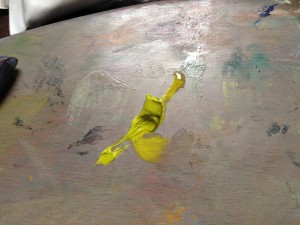Thinning paint and painting layers
|
Oil is a flexible medium. It starts as long molecule chains and slowly it contracts and the molecule links with itself more. It never really dries but polymerises and continues changing slowly over a very long time. However, the rate of change alters enough that you can call a painting dry. This means you have to be careful when you put paints onto other paints. If you put something that will be brittle over a paint that flexes, then any tiny cracks or weaknesses will get bigger over time. If you put a flexible paint over a brittle one, it acts to glue the surface below together, and stretches over it. You might still have a problem with the brittle layer cracking as canvas grows and shrinks with atmospheric conditions, but all told, the paint surface will be stronger. Keeping that in mind, there are two ways of thinning down paint. Oils can be worked at any consistency from stiff concrete through toothpaste to runny cream. Some will vary in the tube because of what is required to keep a pigment in the medium, and others will be thinned down because the artist wants to work with them that way. You can add more oil, altering the ratio of oil to pigment, or you can add a thinner in which oil is soluble. For the lower layers of painting, you should not add oil. Always aim for more flexibility as you get further from the canvas. With one layer, there is no need to worry about that, but you will want to be covering the canvas, so thinning the paint at all is probably a bad idea.
For most paint, you want to use the strongest oil possible – linseed. There is a lot of argument about which sorts are best, but I use linseed stand oil. It has been left around for a long time and has already done most of its yellowing. I then thin that down with my brand of OMS to make something at the consistency of normal linseed oil. Again, there is a potential for it to be slightly porous, but I make it more and more oily as I go over the surfaces, and my style of thin layers of paint benefits from the mix. For colours that are nearly white, and for pale blues, use an oil that will not add yellow, even as it ages. Poppy and safflower seem to be the most popular – I use poppy, but that is because it is what I bought. TLDR; You can thin down with oil or white-spirit substitute, but don’t put oily layers underneath ones with less oil. |

